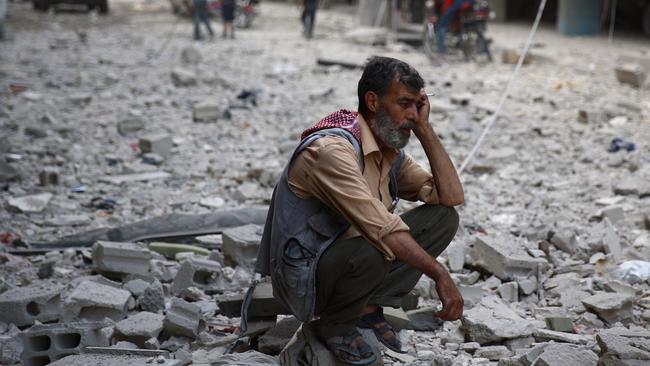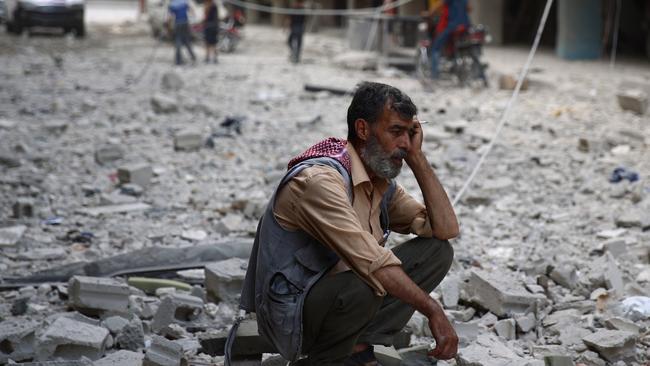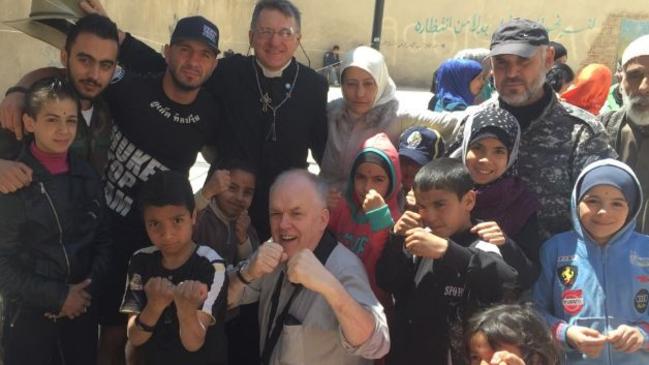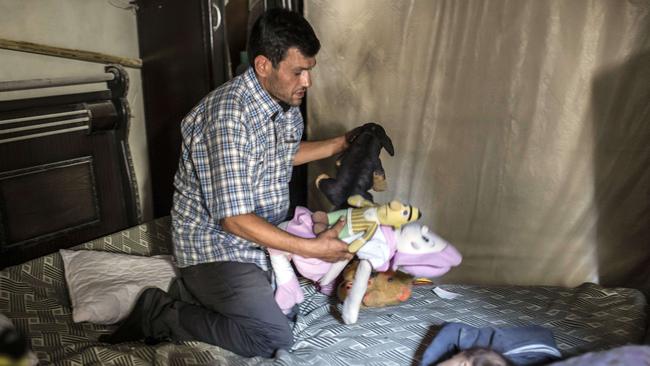Syria explained in 10 simple points. A Western perspective on the crisis
AS DESPERATE people flee in their millions, Australia is launching headlong into this hell on Earth. This is what they are running from.

ALMOST exactly two years ago, as the full horror of Syria’s civil war revealed itself to the world, news.com.au published a basic explainer piece.
That piece, entitled 10 simple points to help you understand the Syria conflict, went on to be one of the most clicked stories ever produced by this website.
To this day, people continue to read it. At any given moment in the day or night, 40 or 50 people from around the world are reading it as they try to comprehend the desperately complicated Syrian situation. Those numbers have surged in recent days and weeks for obvious reasons.
But our original piece is now out of date. So much has happened since 2013, including this afternoon’s announcement that Australia will carry out air strikes against Islamic State (IS).
That’s why we’ve produced this update, with fresh comment from the same two Australian experts we consulted two years ago.
We’ve again spoken to Dr Rodger Shanahan, a former peacekeeper in Syria who is now a Research Fellow at the Lowy Institute for International Policy, as well as Associate Professor at the National Security College at the Australian National University (ANU).
And we spoke once more to Father David Smith, a Sydney Anglican priest who has now made four humanitarian missions to Syria, the most recent in July. You can read Father Dave’s blog here at prayersforsyria.com

1. A reminder of Syria and its origins as a country
Syria is a middle eastern nation with a small strip of Mediterranean coastline. Its overall area is a little smaller than the United Kingdom. Syria first became an independent nation in 1945 and has been formally known as the Arab Republic of Syria since 1991.
Though it has pretences of being democratic, Syria has been led by the al-Assad family for 45 years. Hafez al-Assad ruled from 1970 to 2000. His first son died in a car crash and his second, Bashar al-Assad, has been president since 2000.
2. How the civil war started
In 2011, the people of several middle eastern and North African countries rose up against their leaders in a movement which became known as the Arab Spring. Many of the overthrown leaders were hard-line Islamists. Syria’s ruling family have never been that. The Assad family are Alawites — a branch of Islam which is relatively liberal.
But despite living under a regime which allowed religious and other freedoms, many Syrians were still no fans of Bashar al-Assad. Angry about the failure of long-promised economic and political reforms, and emboldened by the Arab Spring uprisings, a series of anti-government protests began.
For several reasons the protests soon turned ugly. A key flashpoint was the deaths (in detention) of some children who had painted anti-regime graffiti. There were also moments when the government brutally cracked down on protests, firing into the crowd.
Soon, ordinary Syrians took up arms. Many of them were disenchanted former members of Assad’s military. Others were ordinary citizens. As things escalated into a full scale civil war, they were joined by a ragtag bunch of jihadists and others, who crossed borders to join the action on the side of the anti-government rebels.

3. And the war raged on and on: it is impossibly messy
In the two years since we first tackled this issue, the Syrian Civil War has turned into a conflict so complicated, even the experts admit it almost defies description. It’s also a war no one is really winning or can win.
“The war is at stalemate right now with the Syrian government in control of western and central Syria around Damascus, and with patchy control over parts of Aleppo in the north,” explains Dr Shanahan. “Islamic state is more eastern Syria-focused but it’s also in northern Syria.
“There are also a variety of groups like Jabhat al-Nusra which is Al-Qaeda aligned. The bottom line is it’s bloody complex.”
4. To make matters more complicated, everyone now has different aims
In truth, this war was about Syrians versus the Assad regime for about five minutes. Then came the jihadists and then came IS, which as Dr Shanahan explains, wants to expand the caliphate it has loosely established in Iraq and parts of Syria across the whole of Syria.
A caliphate, by the way, is a region governed by hard-line Islamic rule.
But as Dr Shanahan explains, the problem here is competing goals. Every player in this war wants something different.
“The non Islamist [rebel] groups don’t like Assad, IS want to expand the caliphate, groups like Jabhat al-Nusra want Islamic rule in Syria under their leadership, other Islamist groups want Islamic government although what that looks like and how it might be achieved is never articulated. But they all want Islamic rule in one way, shape, or form.”

5. So basically you’ve got an unwinnable war.
Dr Shanahan again: “I think what will end up happening is something short of the collapse of the Assad regime. A reasonable outcome you’d think is a ‘regime lite’ where Assad is not the ruler at an agreed time in the future, and where some opposition elements are incorporated in the government and military. How you get there is the difficulty.”
6. Meanwhile the bodies stack up
Two years ago, the death toll including civilians and combatants was around 100 thousand. That figure is now generally estimated to be 240 thousand. That’s about 1400 Syrians killed as a direct or indirect result of this conflict each week over the last two years. To help you put those numbers in perspective, Syria’s overall population is almost identical to Australia’s 23 million.

7. And the number of refugees is staggering. So why are they heading to Europe now?
By most measures, it appears that as many as 11 million Syrians have been displaced. Of those, 4.1 million have fled the country and been registered as refugees with the UNHCR. The real number of refugees outside Syria is probably much higher.
Why are they heading to Europe now?
“My understanding is that the refugees are moving from Turkey [which shares a southern border with Syria] and my understanding is they are moving from there [towards Europe] because people smugglers have found a route less dangerous and cheaper,” Dr Shanahan says.
“People can’t move in that kind of mass movement without people smugglers who have made the journey more accessible and cheaper. There has been no massive escalation in the war itself. People are just saying ‘we can make it to Europe now so let’s do it’. It’s a case of risk versus return. It’s also summer now in the northern hemisphere, which is a much better time to make a dangerous trip like this than winter.
Unfortunately, as we all saw with the tragic case of drowned toddler Aylan Kurdi, the risk side of that equation remains devastatingly real.
8. Meanwhile, what’s life like for those who remain in Syria?
With four humanitarian missions under his belt, Father David Smith has some amazing insights into the lives of those who both literally and figuratively soldier on in Syria.
He recalls one man he met who joined the rebels because they paid 50 dollars a month and all the cigarettes he could smoke. But he soon figured out that his commander was not even a Syrian (and was probably IS aligned). “I had gone from poverty and unemployment to slavery and beheadings,” the man told Father Dave.
Another man told Father Dave, with his young pretty wife beside him and baby bouncing on his knee, how he’d done his bit for the army by killing up to 1500 people. He wasn’t boasting. He was merely acknowledging how the moral goalposts have shifted in the mess that is present day Syria.
Yet the country itself is far from entirely dysfunctional. “Syria is going a lot better than Iraq thanks be to God,” Father Dave says. “There is a fully functioning bureaucracy. Unlike Lebanon, where garbage has not been collected for months, the garbage is collected in Syria.”
As the country somehow stays functional in most areas, its people maintain their spirits.
“Everywhere we went on our most recent trip in July, we saw thousands of kids, and all had fire in the eyes. They were full of life and spirit.
“The streetlife was extraordinary, despite no lighting at night. People were dancing and drinking and saying ‘I don’t know how much longer I’m going to be alive, we might as well enjoy life’.
“What I didn’t see was a sense of resignation,” Father Dave says. “There is a very strong sense of patriotic solidarity in Syria. People are gathering around the flag and around Assad, even if it’s not to do with him as a person or any decisions he has made.”
It would be ironic if this war, which started as an anti-Assad crusade, ends up making people feel that Assad is the safe option. But there is evidence that the chaos caused by all the various factions in this war may produce exactly that result among the Syrians left behind.
It’s doubly ironic given Dr Shanahan’s assertion that “the one thing unites all the opposition groups, whether Islamists or Free Syrian Army, is that Assad must leave”.
Yet Dr Shanahan concedes that Assad may well represent “if nothing else, stability in a time of chaos”.

9. What about Russia, the Saudis and other external players like the US and Australia?
In short, there is strong evidence the Saudis are funding IS and others involved in Syria. Remember that Syria’s Assad regime are Shia Muslims while the Saudi regime and most Saudis are Sunni Muslims. So the Saudi desire to replace a Shia regime with Sunni Islam is just one of the complications which deeply underpins this conflict.
Iran is also in the mix. What you need to know about Iran is that it is more than 90 per cent Shia. So it has a natural ally with Syria’s rulers and natural enemies elsewhere in the Middle East and Gulf region. So Iran has strong reasons to be supporting the ruling regime.
Russia is an interesting player. It has a base in the Syrian port of Tartus, from where it is just over 1000 nautical miles to Russia’s Black Sea naval bases. Russia supports the Assad regime, which the west does not. Remember, Assad is said to have committed atrocities against his own citizens, including the use of chemical weapons (a claim which is disputed). So the west is not exactly Assad’s best friend.
But nor is the west a friend of the rebels, given the rebels are such a loose, disparate collective which includes IS. In fact we want to bomb IS.
10. So should we bomb IS? Will this in some way help stop the war?
“The Americans’ grand scheme is to degrade IS to relieve pressure on Syrian army units and make room for other people that they’ve trained,” Dr Shanahan explains.
With Australian Prime Minister Tony Abbott announcing a series of air strikes on IS in Syria, experts like Dr Shanahan remain unconvinced of what they’ll achieve.
“Why should Australia bomb Syria? Australia has only got six aircraft. What operational effect will that have? There has just been no strategic intent. The government is wanting to show solidarity with the Americans, but it’s not going to have any kind of operational effect.”
About the only thing we do know for sure is that Syria remains a mess. We’d like to offer you a more hopeful conclusion. But the main reason the world has been standing back and not doing much in Syria is because it’s unclear how to make a difference.
That’s one reason why the world’s attention has swung to the refugee crisis. In this area at least, it’s a little clearer how to contribute in a positive way.




